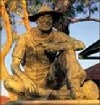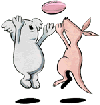|
Australia
has many famous and well know icons.
Here are just a few.
| WALTZING
MATILDA |
 |
A.B. 'Banjo'
Paterson wrote Waltzing Matilda in 1895 while visiting Dagworth
Station, near Winton.
Waltzing Matilda is Australia's national song even though it's not
our National Anthem and it's known the world over!
Visit
the web site of the Waltzing
Matilda Centre, the world's only centre dedicated to a song.
 Click
here to hear Waltzing Matilda Click
here to hear Waltzing Matilda
|
| ADVANCE
AUSTRALIA FAIR (National Anthem) |
|
Advance Australia
Fair was proclaimed as Australia's national anthem by the Governor
General on 19 April 1984.
Visit
DIMA,
the Australian Migration, Settlement
site to learn more
about our national anthem and read the words.
 Click
here to hear Advance Australia Fair Click
here to hear Advance Australia Fair
|
 |
| VEGEMITE |
 |
In
1922 a chemist named Dr Cyril P Callister developed a remarkable new
spread from brewer's yeast and hence an Aussie icon was born.
The result was a nutritious spread with an appealing taste that is
also one of the world's richest known sources of Vitamin B.
Vegemite
Homepage |
| MEAT
PIE |
| Other
countries may also have pies , but Australians love their meat pies,
especially at the footy. Approximately 260 million meat pies are consumed
each year. 62% of pies have chopped steak and gravy as the filling
but other popular choices are steak and kidney, steak and mushroom
and steak and onion. |
 |
|
AKUBRA
|
 |
"Akubra"
is an Aboriginal word for head covering.
The Akubra is more than just a hat, it is an authentic aussie hat.
An aussie Icon known the world over.
Akubra
Hats Homepage |
|
FAMOUS
AUSSIE DUNNY
|
"Dunny"
is Australian slang for a toilet, usually outdoors (outhouse). With
the arrival of sewerage the outdoor dunny became an endangered species..:-)
Here is a little verse that I picked up many years ago, I'm not quite
sure who wrote it......
"By the wood heap, down the yard, a sentinal stands alone. This
relic from another time was often dubbed "The Throne". When
I was young this puzzled me, I thought it was rather funny, to me
and all the kids at school it simply was "The Dunny"."
Outback
Dunny Homepage
|
 |
|
AEROPLANE
JELLY
|
 |
Aeroplane
Jelly are small packets of coloured jelly crystals and were first
marketed in 1927. There's nothing special about jelly but Aeroplane
Jelly is well known for its jingle. All Australians over 30 probably
know it by heart. Here it is:..... "I like Aeroplane Jelly, Aeroplane
Jelly for me. I like it for dinner, I like it for tea. A little
each day is a good recipe. The quality's high as the name will imply.
And it's made from pure fruit, one more good reason why I like Aeroplane
Jelly, Aeroplane Jelly for me."
|
|
CAPTAIN
JAMES COOK (1728 - 1779)
|
|
|
|
In 1770, Captain
James Cook, the well known Pacific explorer, with the ship of his
first voyage, the "HMS Endeavour", discovered the East Coast of
Australia. Upon landing at a place now called Kurnell in Botany
Bay, on April 29, 1770, he claimed the whole east coast for King
George III and called it New South Wales. Botany Bay was later to
become the destination for the first convict ships that arrived
from England in 1788.
James Cook was
born in the village of Marton, Yorkshire on October 27, 1728. He
was one of seven children born to a day laborer. Cook received basic
schooling at the village school and was then sent to work for William
Sanders in the nearby fishing village of Staithes. Here Cook developed
a love and fascination for the sea, but he was not happy with his
job. In July 1746, at the age of 17, Cook became an apprentice to
the Walker Family, ship owners, at the port of Whitby. He had his
first voyage aboard the Whitby collier ‘Freelove.' While Cook was
at Whitby, he educated himself in navigation and mathematics. By
1755, after nine years, and service as ship's master, Cook left
his ship and enlisted in the Royal Navy as an ordinary sailor. In
the Navy James Cook worked his way up through the ranks very quickly,
eventually rising to command his own survey vessel. He was unknown
outside of the Navy when the British Admiralty placed him in command
of a small scientific expedition to the recently discovered Tahiti
to observe a transit of the planet Venus. The subsequent publication
of his journals of this voyage made him one of the most famous men
of his time. (The surveys were so accurate and complete that they
were in use until the beginning of the Twentieth Century.) Because
of this reputation he was awarded the first modern scientific exploratory
missions for his next two voyages. He had the will, and now the
means, to seek out every uncharted area in the oceans of the world,
and prove or disprove the discoveries of others who had discovered,
or claimed to have discovered, new lands by chance. During the course
of these voyages he gathered scientific data on the people and the
flora and fauna of every new land he visited. On the 14th February
1779 Captain James Cook was killed, tragically, by the natives of
Kealakekua Bay, on the island of Hawaii.
|
|
NED
KELLY (BUSHRANGER 1854 - 1880)
|
|
|
|
Ned Kelly is
Australia's best known bushranger, earning his reputation in various
daring bank robberies during his short career, being described as
a rogue and a villain by certain people, the man with the bucket
on his head by others and Australia's last great folk hero by more
sympathetic people.
The most memorable
thing associated with Ned Kelly is the suits of armour worn by him
and other members of the Kelly gang to protect themselves during
shoot-outs with the police. Especially the head piece.
Click
here to read Ned Kelly's Story!
|
You don't speak
english? Use this translator!
Translate a few words or the whole page!
|

